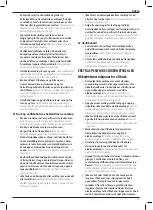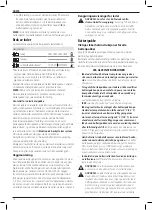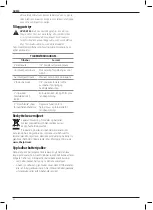
11
English
of charge in the battery is below the usable limit, the fuel gauge
will not illuminate and the battery will need to be recharged.
nOTE:
The fuel gauge is only an indication of the charge left on
the battery pack. It does not indicate tool functionality and is
subject to variation based on product components, temperature
and end-user application.
Mounting the Backing Pad into the Spindle
(Fig. C)
1. With the collet
6
loosened, insert the backing pad
mandrel
11
through the collet and into the spindle
5
.
2. While holding the spindle in place with one of the supplied
wrenches use the other wrench
8
to tighthen the collet
onto the spindle.
nOTE:
To remove the backing pad from the spindle loosen
the collet using both wrenches.
Attaching and Removing Polishing Pad or
Surfacing Disc (Fig. D)
Hook and loop pads and discs
12
with a diameter of up to
75 mm may be used with the MCM401 They can be adhered
easily by pressing the back of the accessory to the hook and
loop surface of the backing pad
11
.
Prior to Operation
1. Be sure the polishing pad is mounted correctly.
2. Make sure the pad rotates in the direction of the arrows on
the accessory and the tool.
3. Make sure any dirt is washed off the workpiece surface.
OPERATION
Instructions for Use
WARNING:
Always observe the safety instructions and
applicable regulations.
WARNING: To reduce the risk of serious personal
injury, turn tool off and disconnect battery pack
before making any adjustments or removing/
installing attachments or accessories.
An accidental
start-up can cause injury.
Proper Hand Position (Fig. E)
WARNING:
To reduce the risk of serious personal injury,
ALWAYS
use proper hand position as shown.
WARNING:
To reduce the risk of serious personal
injury,
ALWAYS
hold securely in anticipation of a
sudden reaction.
Proper hand position requires one hand on the main handle
13
and one hand on the top of the polisher.
Variable Speed Trigger Switch (Fig. A)
The variable speed trigger switch permits speed control from 0
to 9000 RPM.
To turn the tool on, squeeze the trigger switch
4
. The farther
you depress the trigger, the faster it will operate. Releasing the
trigger turns the tool off.
Use lower speeds for applying compounds, and higher speeds
for polishing.
Speed Control Switch (Fig. A)
The three-speed feature of your tool allows you to change
speed for greater versatility.
• To select Speed 1 slide the gear speed control switch
3
all
the way to the left.
• To select Speed 2 slide the gear speed control switch to the
middle position.
• To select Speed 3 slide the gear speed control switch all the
way to the right.
nOTE:
Do not change speed when the tool is running. Always
allow the tool to come to a complete stop before changing
speed. If you have trouble changing speed, depress and release
the trigger switch and try again.
Tool settings
RPM
Speed 1
0–3000
Speed 2
0–5000
Speed 3
0–9000
Polishing (Fig. E)
1. Without turning the tool on, grasp the handle of the tool
and pick it up.
2. Keep the tool away from your body and depress the
trigger switch.
3. Make sure you have a firm grip on the handle.
4. Move the tool evenly over the surface of the workpiece,
without applying pressure.
5. Switch off the machine before taking the tool from
the surface.
6. Check your work at short intervals.
Use utmost care when power polishing around or over sharp
objects and contours. It is very important to use the correct
pressure while polishing various sections of an automobile
body. For example, light pressure should be applied when
polishing over sharp edges of body panels, or over edges of the
rain gutter along the top.
WARNING:
High-speed rubbing action of the polishing
bonnet upon the workpiece surface can build a static
charge on the metal portions of this tool resulting in a
static shock when touched.
MAINTENANCE
Your Mac Tools power tool has been designed to operate
over a long period of time with a minimum of maintenance.
Continuous satisfactory operation depends upon proper tool
care and regular cleaning.
WARNING: To reduce the risk of serious personal
injury, turn tool off and disconnect battery pack
before making any adjustments or removing/
installing attachments or accessories.
An accidental
start-up can cause injury.
The charger and battery pack are not serviceable.
Summary of Contents for MCM401
Page 1: ...MCM401 Final page size A5 148mm x 210mm ...
Page 3: ...1 Fig A Fig B 1 2 3 4 5 8 x2 6 7 2 1 2 1 10 XXXX XX XX 9 ...
Page 4: ...2 Fig E Fig C Fig D 6 11 8 5 13 12 11 ...
Page 45: ......
Page 46: ......
Page 47: ......














































